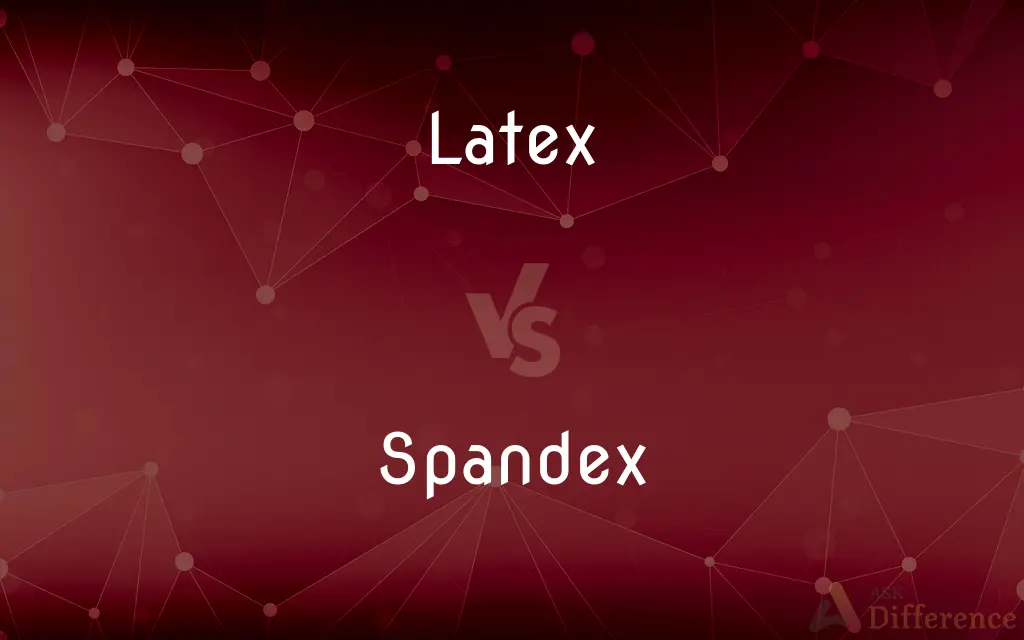Latex vs. Spandex — What's the Difference?
Edited by Tayyaba Rehman — By Urooj Arif — Updated on March 7, 2024
Latex is a natural rubber material known for its elasticity and biodegradability, while Spandex is a synthetic fiber celebrated for its exceptional stretchability and strength.

Difference Between Latex and Spandex
Table of Contents
ADVERTISEMENT
Key Differences
Latex, derived from the sap of rubber trees, is notable for its natural origin and biodegradability, making it environmentally friendly. In contrast, Spandex, also known as elastane, is a synthetic fiber engineered for extreme elasticity, outperforming latex in stretchability and durability. This difference in origin plays a significant role in their applications and environmental impact.
Latex offers a unique combination of comfort and breathability, making it ideal for medical gloves and mattresses. Whereas, Spandex's superior stretch and recovery properties make it a preferred choice in activewear and swimwear, providing unparalleled freedom of movement.
The production process of latex involves tapping rubber trees and collecting the sap, a sustainable practice that supports the ecosystem. On the other hand, Spandex is produced through a chemical synthesis process, involving petrochemicals, which has a higher environmental footprint.
Regarding allergenic properties, latex can cause allergic reactions in some individuals, a concern not typically associated with Spandex. This makes Spandex a safer option for skin-sensitive applications, such as clothing and medical equipment.
Latex products are generally less durable compared to Spandex items. Latex can degrade over time, especially when exposed to elements like sunlight and oils, while Spandex maintains its integrity and elasticity even under frequent use and washing.
ADVERTISEMENT
Comparison Chart
Origin
Natural (rubber tree sap)
Synthetic (petrochemicals)
Elasticity
Highly elastic
Extremely elastic
Environmental Impact
Biodegradable, eco-friendly
Less eco-friendly, not biodegradable
Applications
Medical gloves, mattresses
Activewear, swimwear
Allergenic Properties
Can cause allergies
Hypoallergenic
Compare with Definitions
Latex
Natural Rubber.
The balloons are made of latex, derived from rubber trees.
Spandex
Synthetic Fiber.
The leggings contain spandex for stretchability.
Latex
Elasticity.
Latex bands are used for resistance training due to their elasticity.
Spandex
Highly Elastic.
Spandex fibers can stretch over five times their original length.
Latex
Allergy Concerns.
Some people wear vinyl gloves as they're allergic to latex.
Spandex
Versatile Use.
Spandex is used in both swimwear and outerwear for its flexibility.
Latex
Breathable Material.
Latex mattresses are praised for their breathability.
Spandex
Hypoallergenic.
Spandex is a good choice for sensitive skin, avoiding latex allergies.
Latex
Biodegradable.
Latex products naturally break down over time.
Spandex
Durable.
Spandex is more resistant to sweat and oils than other fabrics.
Latex
Latex is a stable dispersion (emulsion) of polymer microparticles in water. Latexes are found in nature, but synthetic latexes are common as well.
Spandex
A synthetic fiber or fabric made from a polymer containing polyurethane, used in the manufacture of elastic clothing.
Latex
A milky fluid found in many plants, such as poppies and spurges, which exudes when the plant is cut and coagulates on exposure to the air. The latex of the rubber tree is the chief source of natural rubber.
Spandex
Clothing made from such material.
Latex
The colorless or milky sap of certain plants, such as the poinsettia or milkweed, that coagulates on exposure to air.
Spandex
An elastic synthetic fabric
Latex
A polymer emulsion consisting of such sap obtained from rubber trees, used to manufacture various thin elastic products such as balloons, disposable gloves, and medical and contraceptive devices. Some people are allergic to this substance. Also called natural rubber latex.
Spandex
Spandex, Lycra, or elastane is a synthetic fiber known for its exceptional elasticity. It is a polyether-polyurea copolymer that was invented in 1958 by chemist Joseph Shivers at DuPont's Benger Laboratory in Waynesboro, Virginia, US.The generic name "spandex", which is an anagram of the word "expands", is the preferred name in North America.
Latex
A similar material made from polymers derived from petroleum; synthetic latex.
Spandex
A type of stretchy polyurethane fabric
Gold spandex leggings
Latex
Latex paint.
Spandex
Of or relating to spandex or its elastic qualities.
Latex
A clear liquid believed to be a component of a humour or other bodily fluid esp. plasma and lymph
Spandex
A synthetic fibre known for its exceptional elasticity.
Latex
The milky sap of several trees that coagulates on exposure to air; used to make rubber.
Spandex
An elastic textile material, used for clothing
Latex
An emulsion of rubber in water, used in adhesives and the like.
Latex
(uncountable) Natural latex rubber, especially non-vulcanized rubber, such as is used in making latex gloves, latex condoms, and latex clothing.
Latex
A milky or colored juice in certain plants in cavities (called latex cells or latex tubes). It contains the peculiar principles of the plants, whether aromatic, bitter, or acid, and in many instances yields caoutchouc upon coagulation. The lattex of the India rubber plant produces the rubber of commerce on coagulation.
Latex
Any aqueous emulsion of finely divided rubber or plastic particles, especially such an emulsion used as a base for paint; as, a latex paint.
Latex
A milky exudate from certain plants that coagulates on exposure to air
Latex
A water-base paint having a latex binder
Common Curiosities
Is spandex a natural material?
No, spandex is a synthetic material made from petrochemicals.
What makes spandex preferable for sportswear?
Its extreme elasticity and durability make spandex ideal for sportswear.
Can latex cause allergies?
Yes, some individuals may experience allergic reactions to latex.
What are the main uses of spandex?
Spandex is primarily used in activewear, swimwear, and stretchable garments.
Are latex products biodegradable?
Yes, latex products are biodegradable and environmentally friendly.
Which is more elastic, latex or spandex?
Spandex is more elastic than latex.
Can spandex be worn by people with latex allergies?
Yes, spandex is hypoallergenic and safe for people with latex allergies.
Is latex environmentally friendly?
Yes, latex is considered environmentally friendly due to its biodegradability.
Is spandex breathable like latex?
Spandex is not as breathable as latex but is often blended with other fibers to improve breathability.
Which material is better for waterproof applications?
Both materials have water-resistant properties, but their suitability depends on the specific application.
What is latex made from?
Latex is made from the sap of rubber trees.
How is latex harvested?
Latex is harvested by tapping rubber trees and collecting the sap.
Can spandex degrade over time like latex?
Spandex is more resistant to degradation from elements like sunlight and oils compared to latex.
Do both materials have similar care requirements?
No, spandex is generally more durable and resistant to oils and sweat than latex.
How do the production processes of latex and spandex differ?
Latex is produced through natural means, while spandex requires a chemical synthesis process.
Share Your Discovery

Previous Comparison
Absolve vs. Resolve
Next Comparison
Envelope vs. LetterAuthor Spotlight
Written by
Urooj ArifUrooj is a skilled content writer at Ask Difference, known for her exceptional ability to simplify complex topics into engaging and informative content. With a passion for research and a flair for clear, concise writing, she consistently delivers articles that resonate with our diverse audience.
Edited by
Tayyaba RehmanTayyaba Rehman is a distinguished writer, currently serving as a primary contributor to askdifference.com. As a researcher in semantics and etymology, Tayyaba's passion for the complexity of languages and their distinctions has found a perfect home on the platform. Tayyaba delves into the intricacies of language, distinguishing between commonly confused words and phrases, thereby providing clarity for readers worldwide.
















































